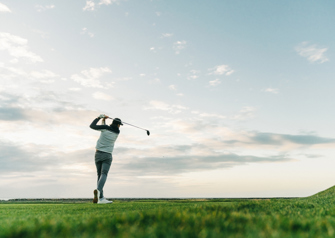
News
Treating and preventing golf injuries like a pro
Date posted: 6/13/2023
Last updated: 6/13/2023
Table of Contents
With the US Open starting soon, golf fans nationwide will be watching how the pros play. Most pros are in top shape, but some may be dealing with injuries that can slow them down -- or take them out of competition entirely. Some players, like Tiger Woods, are known for overcoming orthopedic injuries, while others seem to have kept serious aches or pains at bay.
For amateurs, there are a lot of common golf injuries that could leave them behind in the clubhouse. A recent study showed that lower back pain accounts for between 18% and 54% of all documented ailments. However, the back is followed closely by elbow, shoulder, hip, and knee pain.
The sports medicine physicians at Midwest Orthopaedics at Rush help patients every day with a variety of sports-related injuries. When warmer weather arrives, they begin seeing an increase in the number of patients with these common golf injuries.
Most common injuries among golfers
- Low back pain
- Elbow tendonitis, or golfer’s elbow
- Rotator cuff injury and shoulder pain
- Knee pain
- Hip pain
“Many golfer’s injuries, like golfer’s elbow and lower back pain, can be treated conservatively,” explains Dr. Nik Verma. “Don’t assume because you have pain while playing that you need surgery. It’s important to get your condition evaluated so that a provider can help you with a treatment plan and you can enjoy the golf season.”
But when conservative treatment, such as physical therapy, pain medication, and injections, no longer provide relief, surgery might be an excellent option to return a golfer to the course.
Back on course following surgery
Meet these golfers who have successfully recovered and are back in the swing following an orthopedic condition and surgery:
Hip
Barry Moze, 69, a golfer with a two handicap, played with hip pain for more than five years. “I really didn’t want to have surgery,” he explains. Although he was playing 75 rounds a year, eventually he couldn’t move his lower body after five or six holes. “My handicap was increasing, and I knew it was time to address my pain,” he says. Moze contacted a friend who had recently had a great hip replacement experience with Dr. Craig Della Valle. He trusted him right away and just three months after a successful total hip replacement, Moze was back on the course. “I’ve had to re-learn my swing because I no longer have to compensate for hip pain but I’m eager to get my handicap back.” He’s on track to play 150 rounds this year; double the (now pain-free) rounds than before hip surgery.
Shoulder
Swetal Vaidya, 54 of Lisle, plays multiple sports (tennis, pickle ball, cricket, golf) and enjoys boot camp-style workouts and riding his motorcycle. He admits that cricket and golf are his favorites which he plays at various fields and courses around Chicago. In addition to playing golf once a week, he typically hits the driving range three times a week. “When my shoulder pain started to creep down to my elbow and wrist, and sleeping on my side and just holding the golf cart steering wheel became difficult, I knew it was time to contact Dr. Nikhil Verma for an exam,” Vaidya explains. An MRI showed a torn labrum and rotator cuff tendon and Dr. Verma recommended repair surgery to get him back to the sports he loves. During the surgery, Dr. Verma also discovered a torn bicep tendon which he also repaired. Just six months after this ‘three in one’ surgery, Vaidya was back swinging the club with no pain. One year later he was back to high-intensity fitness classes.
Back
Pete DeBruin, 41, of Downers Grove, has been a lifelong athlete. He has played golf for many years and eventually acquired a five handicap. When back pain from degenerative disk disease started, he tried everything including physical therapy, massage, and treatment by a chiropractor. “When I realized that I hadn’t really slept in eight months, I knew it was time to see a spine surgeon,” he says. The first surgeon he visited discussed his technique which included cutting muscles and a six to eight-month recovery. DeBruin was discouraged by this and went home. Shortly thereafter, he spoke with a friend who had undergone minimally invasive spine surgery by a href="https://www.rushortho.com/doctors/frank-phillips">Dr. Frank Phillips. “After meeting with Dr. Phillips, his approach sounded much better,” DeBruin says. He underwent surgery and just three months post minimally invasive spinal fusion surgery with Dr. Phillps, DeBruin was swinging a golf club in physical therapy. At the five-month mark, he was back on the golf course pain-free. His goal is to get back to that pre-surgery handicap and Dr. Phillips has no doubt he will.
Injury prevention
“I recommend golfers get to the course early and develop a warmup routine that involves some initial dynamic stretches, before full swings,” says Dr. Frank Phillips. “You’ll also want to loosen your back up before the round on the driving range starting with half swings and progressing to full swings. The goal is not to hit as many balls as possible but rather to loosen up the back and feel your swing tempo. This routine gives you the best chance of staying injury-free.”
Here are some good, simple exercises recommended for golfers by the physical therapists at Midwest Orthopaedics at RUSH:
The open book
This stretch involves rotation, which is super helpful for golf, as 90 percent of the speed in your golf swing comes from rotation. Maximizing your lumbar spine range of motion is another benefit.
Lay flat on your back. Pull your right knee toward your chest and then rotate to lay your right leg over your left leg. From here, lay both arms out horizontally. Move your head so you are looking toward your right hand and relax into the stretch. When done, repeat on the other side.
Forward lunge with rotation
Begin in a standing upright position with your feet shoulder-width apart and hands resting on your waist. Step forward with one leg, lowering your body into a lunge position, and rotate your torso to the side. Then carefully return to the starting
position. Repeat on the other side. Make sure not to let your knees collapse inward during the exercise.
Side to side leg swing
Stand in an upright position. Swing one leg across your body in front of you and out to the side several times to open up the hip. Repeat on the other side. Keep your movements controlled and maintain your balance during the exercise.
Inchworm walkout
Begin in a standing upright position. Bend your hips and lean forward to touch the ground. Slowly walk your hands forward with your legs straight until you reach a push-up (or plank) position. Then slowly walk your feet back toward your hands with your knees straight, and repeat. Be careful to keep your back straight and avoid locking your arms and legs during the exercise.


